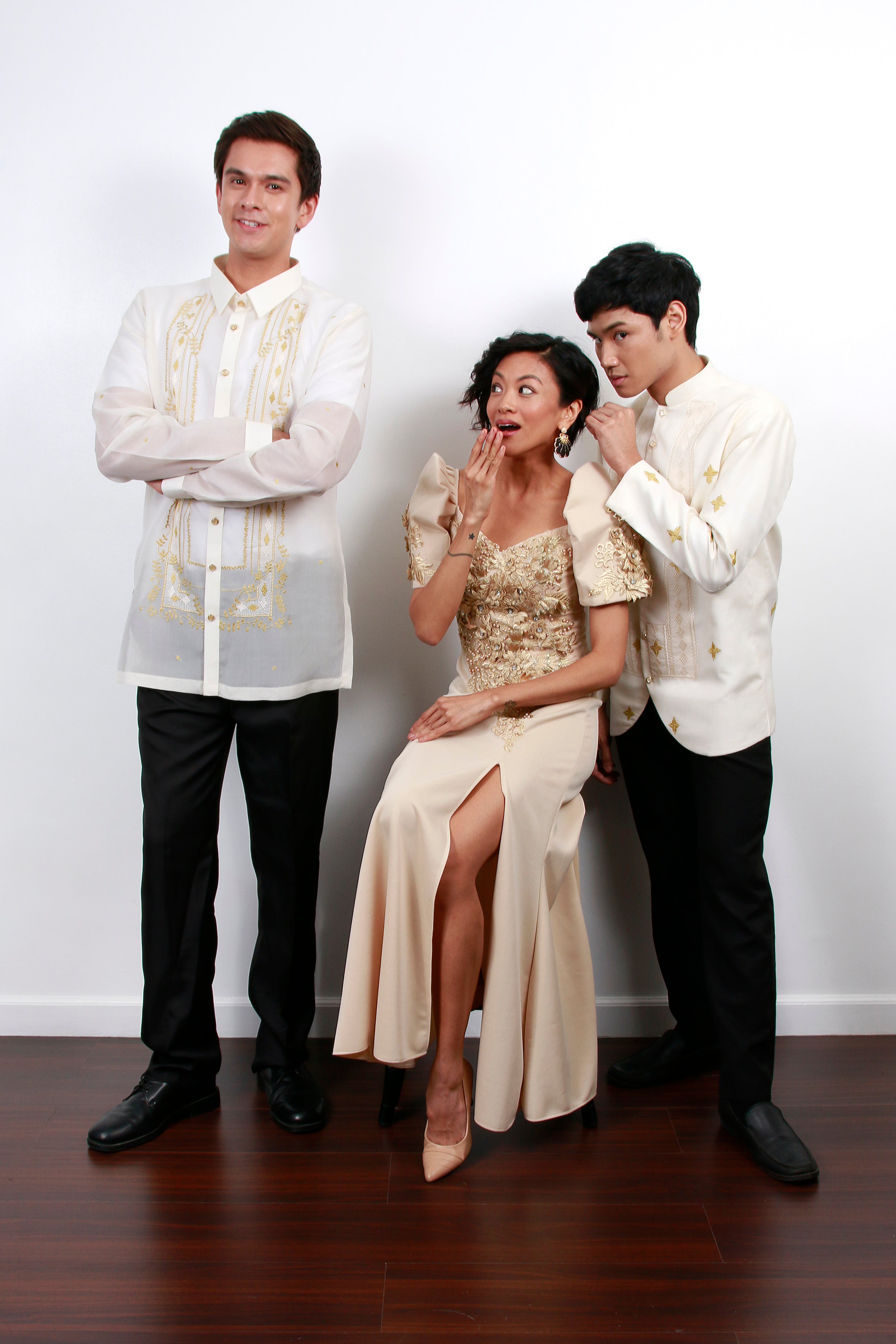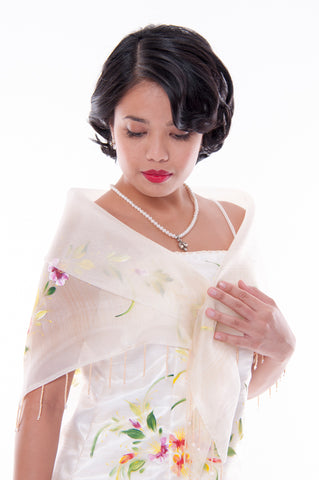Don't know Filipino, but want to know what Filipino traditional clothing is all about? Here is a glossary of terms you'll find in our site and other Philippine-made clothing content.
By the way, "atbp." stands for "at iba pa", which means "and others more" or the Filipino version of "etc." or "etcetera".
Alampay
Arras
A traditional staple of a Filipino wedding symbolizing future prosperity for the bride and groom, these wedding unity coins are also known as "arras". It is usually presented at the wedding church ceremony and blessed by the priest or officiant. Get your own arras and other wedding accessories here.
Barong Coat
A modern and thicker barong tagalog for those who don't like translucent barongs or need a barong for colder weather. Its outer shell is usually made of Piña, Jusi, or Organza and it is usually lined with Satin, Polyester, or other similar fabrics. Depending on the price, it is embroidered by hand (more premium) or by machine (more affordable). Get your own barong coat here.
Barong Tagalog
The Barong Tagalog also known simply as “Barong” or originally as “Baro ng Tagalog” (dress of the Tagalog) is the Official Filipino National attire. With the exception of its longer length and bottom side slits, it has a similar cut to a men’s dress shirt. It comes in varied natural fabrics such as Jusi, Piña, Organza, Jusilyn, Cocoon, Abaca, and more. It can be long or short-sleeved with various collars, colors, embroideries, appliques, and/or paintings. It is predominantly worn by men, but there are female variations as well.
Get your own men's barong tagalog here.
Get your own women's barong tagalog or kimona here.
Baro't Saya
"Baro't Saya" directly translates to "Shirt and Skirt". It's the basic outfit of the classic Filipiniana look. It comes with a top (usually a kimona with butterfly or bell sleeves) and a skirt, and is often accessorized with an alampay (see above), and tapis (see below). All the garments can be adorned with embroidered, painted, cutwork, and/or beaded details. Get your own Baro't Saya or other Filipiniana outfit here.
Bihis Mayaman
"Bihis Mayaman" loosely translates to "Clothing of the Rich". The Bihis Mayaman is a staple in the Filipino work attire and a comfortable twist to the barong tagalog. Due to its material composition, the Polyester nicknamed "Hugo Boss" by Filipino sewers, this style of barong only has simple embroidery, because more ornate designs cause the fabric to be eaten by the embroidery machine. Made out of cool and light Polyester, this is a more affordable choice than the Gusot Mayaman (see below) for many to wear to the office or as an alternative to the guayabera for outdoor events. Get your own Bihis Mayaman here.
Butterfly Sleeve
“Butterfly sleeves” are the distinct flared and standing sleeves of Filipiniana tops, sets, or gowns. They are perfectly rounded with stiff lining and an ornate shell often decorated with embroidery, beading, sequins, cutwork, lace, or other designs. The sleeve height is usually 3” or longer.
Check out Designs with Butterfly Sleeves and other Filipiniana Designs
Camisa de Chino
Made out of 100% Cotton with a slim fit and cuffed sleeves, camisa de chinos or camisas de chino stay cool and in place under barongs better than other plain T-shirts. These are often mistaken for Henley shirts because of their similar scoop neck and distinct three buttons, but these are more fitted and not as thick. Traditionally, white or beige color is worn under the barong tagalog. However, other colors such as red, blue, yellow, green, lavender, gray, and more are available for more festive occasions. One can choose between short or long sleeves depending on your wants and needs for your event. Get your own camisa de chino here.
Filipiniana
This is an umbrella term for any piece of clothing or combination of clothing worn traditionally by Filipino women or Filipinas. Alampays, Baro't Saya, Butterfly Sleeves, Terno, and Traje de Mestiza (see above and below) are common terms of Filipiniana clothing.
This is an umbrella term for any piece of clothing or combination of clothing worn traditionally by Filipino women or Filipinas. Alampays, Baro't Saya, Butterfly Sleeves, Terno, and Traje de Mestiza (see above and below) are common terms of Filipiniana clothing.
Click here for Filipiniana Dresses, Gowns, and Sets or Ternos.
Gusot Mayaman
"Gusot Mayaman" loosely translates to the "Wrinkled of the Rich". Wear these barongs casually, at the office, or an outdoor event. The Gusot Mayaman is a staple in the Filipino work attire or beautiful beach weddings. Due to its material composition, this style of barong only has simple embroidery, because more ornate designs cause the fabric to be eaten by the embroidery machine. Made out of cool and light Linen, this is a more premium choice than the Bihis Mayaman (see above) for many to wear to the office or as an alternative to the guayabera for outdoor events. Get your own Gusot Mayaman here.
Jusi
The Jusi Barong is ideal for those who don’t want to spend a lot of money on a barong but still want a more refined and classic look. Made out of a type of silk, this barong is more opaque and softer to the touch than the Organza but is still less expensive than the Piña Barong. Just like the Organza fabric, the Jusi material can be found in many different colors and styles. One particular style is the Jusi-Piña Barong, which is Jusi, but has small stripes that resemble that of the Piña fabric. Another style is the Monochromatic Jusi Barong, which has been hand-dyed to have a gradient or hombre effect of color from the top of the garment to the bottom. To get a Jusi Barong for yourself, click here to go to Barong Warehouse’s many different styles.
Jusilyn
Similar to Jusi, but more affordable is the Jusilyn Barong, which is also made out of Silk (and Polyester blend) and is more opaque than Jusi. This fabric is often machine embroidered and comes in various colors that can match the color theme of most wedding and occasions. Click here to see our selection of Jusilyn barongs.
Kimona
This is the Filipiniana top that usually has bell sleeves. The modern silhouette is more tapered compared to its more billowy traditional counterpart. It is often embroidered, painted, and/or beaded. Its cut can be loose or tailored, and it can come with with butterfly sleeves (see above) or bell sleeves (as pictured). Some modern kimonas made out of Organza come with an undershirt (as pictured), while others have a Polyester lining. Get your own kimona here.
Linen
With barongs, this fabric is usually used for the Gusot Mayaman (see above). Because Linen is lightweight and keeps cool, it is a great material for tropical clothing such as the barong tagalog and slacks. Get your own Linen fabric or Gusot Mayaman barong here.
Maria Clara
This is the look made popular by the female protagonist, María Clara de los Santos, in Jose Rizal's novel, Noli Me Tángere. The most distinct visual aspect of this look is the Alampay (see above) over the shoulders. She is the classic view of a Filipina who is not only traditionally beautiful, but also polished, feminine, and demure. Get your own Filipiniana Maria Clara look with an Alampay here.
Mestiza Bolero
A beautiful Filipiniana ensemble can be created with this bolero that has Butterfly Sleeves (see above). This is a cropped jacket you can wear over a good fitting and solid color top with skirt or dress for an instant Filipiniana look. Made out of Organza with Polyester lining, it is often decorated with embroidery, sequins, beading, appliqués, or other details, and comes with various colors that can fit any occasion. Get your own Mestiza Bolero here.
Office Barong
Wear these barongs casually or to the office. Known as the Gusot Mayaman (see above) or Bihis Mayaman (see above), they are usually made of Linen, Polyester, and sometimes, Jusi. They still have the U-embroidery distinctive of barongs, but due to fabric restrictions, the embroidery is more simple and geometric compared to their more formal barong counterparts. These barongs are so comfortable, they're often the barong of choice for beach weddings or other outdoor sunny events. Get your own Office Barong here.
Organza
The Organza Barong is the most affordable and cost-effective. This sheer and transparent material made up of Silk and Polyester is the lowest price you can find the Barong Tagalog in. Its shiny appearance is perfect for some who want to stand out in a crowd. If you’re wearing it for a performance of some sort, you will definitely light up on stage with an Organza Barong. Another occasion the Organza Barong works well in is if you only need to wear a barong once, or as they say, “One-time, big-time.” It is relatively inexpensive to get an Organza Barong at Barong Warehouse, and you simply have to click here to shop for one now.
Pañuelo
Piña
The Piña Barong is the ultimate statement of Barong Tagalog elegance. Originally-made in the Philippines, the Piña fabric is meticulously woven by local artisans who have combined age-old Filipino weaving techniques with European hand-embroidery traditions. Because it is so hard to make and so fine to the touch, getting a Piña Barong can be a real investment for Barong Tagalog aficionados. Its prices can range anywhere from a few hundred to thousands of dollars depending on the designer or how fine the particular Piña fabric is.
To achieve the textured Piña look, many barongs made out of Jusi, Jusilyn, or Organza have painted Piña lines.
As an alternative to pure Piña barongs, we have Cocoon Piña barongs and Silk Piña barongs. These are premium barongs made out of woven Piña and Silk, yet are slightly more affordable. They are also hand-embroidered and are quite stunning for any occasion. Get your own Cocoon or Silk Piña barong tagalog here.
Salakot
Bring a touch of the island vibe with this native hat that covers the face and neck very well. It is shaped like a triangle and usually made with reed or straw. This hat is often worn as a costume for school international events or Filipino-themed parties.
Get your own Adult Salakot Hat here.
Get your own Kids' Salakot Hat here.
Check out more Filipino Goods here.
Tapis
"Tapis" is a square piece of adorned fabric that is worn over the saya or skirt. Usually tied at one corner, it adds a layered appeal to the Filipiniana outfit and/or hides the occasional see-through material of the skirt underneath. Get your own Filipiniana costume here.
Terno
“Terno” means matching clothes in Spanish. A matching "baro't saya" has a top and skirt made of the same material, the same color, and/or has the same details. The Filipiniana Terno is the Filipiniana dress with the iconic butterfly sleeves. It evolved from the Baro't Saya and Traje de Mestiza to the modern one-piece terno we see today. It's become less about matching separate pieces, but more about the glamour of the complete look a designer terno embodies.
Get your matching Terno and other Filipiniana outfits here.
Traje de Mestiza
This is another term for the Filipiniana dress and the more aristocratic Baro't Saya (see above). Traje de Mestiza directly translates into "Costume of the Fair-Skinned". It's often associated with the "Maria Clara" (see above) look that was made famous in Jose Rizal's novel Noli Me Tángere. Get your Filipiniana dress here.
***
Questions? Email us at info@barongwarehouse.com for any inquiries.
Would you like to order? Check out all the clothing mentioned above by clicking here.





























Share:
Barong Tagalog Importance to Filipino Identity Today
Different Types of Barong Tagalog for Different Occasions